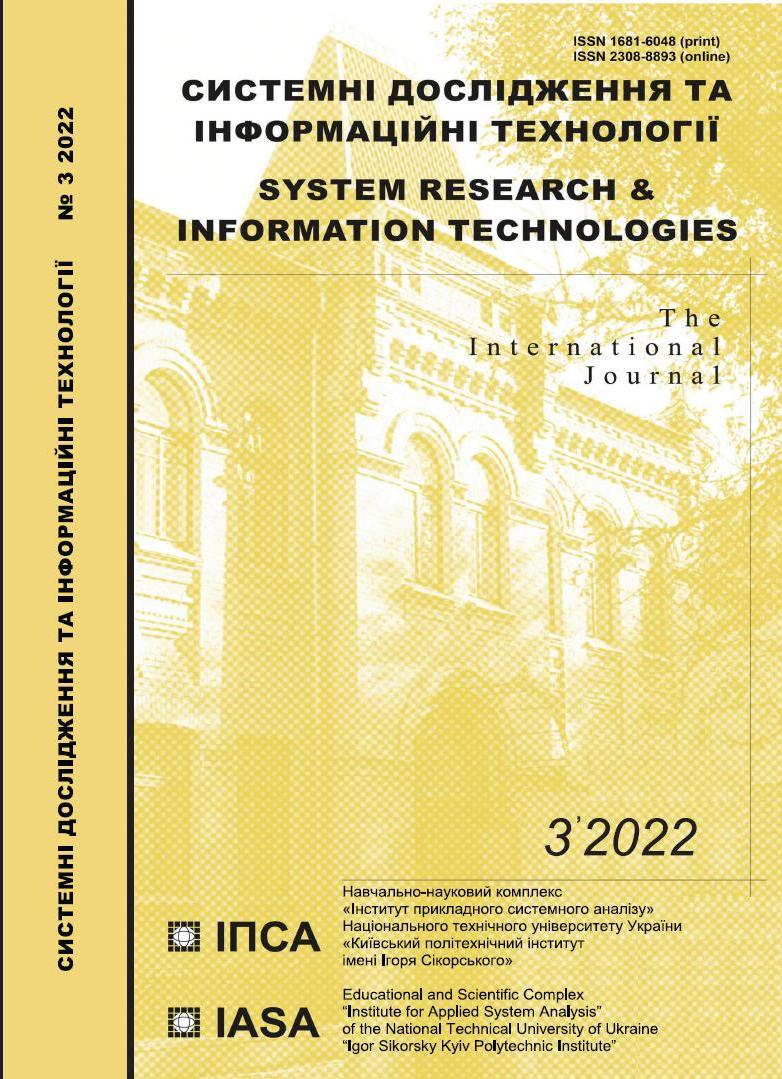The use of environmental decision support systems for modeling of atmospheric pollution following the chemical accidents
DOI:
https://doi.org/10.20535/SRIT.2308-8893.2022.3.04Keywords:
atmospheric dispersion, RODOS system, hazardous substances, ammonia, LASAT, DIPCOT, “Povіtrya” systemAbstract
We studied the possibility of the combined application of screening models to assess the characteristics of sources in accidents at storage facilities for hazardous substances with complex models of atmospheric transport as part of modern decision support systems to calculate air pollution in a wide range of spatial and temporal scales. The evaporation time following an emergency spill, estimated by screening models, is used to set the emission intensity and calculate the atmospheric transport by the RODOS nuclear emergency response system. For the accident in Chernihiv on March 23, 2022, it was estimated that the maximum permissible concentration of ammonia 0.2 mg/m3 was exceeded at distances up to 75 km from the source. The dependence of the calculated maximum concentrations on time is close to asymptote cmax ~ t-4.5 up to 15 h after emission, which is consistent with the asymptote σ ~ t3/2 for the time dependence of the sizes of puffs following turbulent dispersion of instantaneous releases.
References
J.E. Cudney-Black et al., Hazardous Chemical Inventory Guidelines, Purpose and Process. Sandia National Lab., Albuquerque, New Mexico, USA, Rep. SAND2021-8639, 2021. doi: 10.2172/1821974.
C.J.H. van den Bosch and R.A.P.M. Weterings, Eds., Methods for the calculation of physical effects due to releases of hazardous materials (liquids and gases) – ‘Yellow Book’ (Publication series on dangerous substances); 3d ed. The Hague, The Netherlands: Director-General of Labor : Committee for the Prevention of Disasters, 2005.
“Recommendations on forecasting the consequences of spills (emissions) of hazardous chemicals at industrial facilities and transport,” (in Ukrainian), Ministry of Ukraine of Emergencies and Affairs of Population Protection from the Consequences of Chernobyl catastrophe. Kyiv, 2001. Accessed on: Jun 6, 2022. [online]. Available: https://zakon.rada.gov.ua/laws/show/z0326-01.
“Method of assessment of chemical situation following accidents at facilities containing toxic substances,” (in Russian), Ministry of Defense of USSR. M., 1989.
U. Janicke and L. Janicke, “Lagrangian particle modeling for regulatory purposes; A survey of recent developments in Germany,” in Proc. of the 11th International Conference on Harmonisation within Atmospheric Dispersion Modelling for Regulatory Purposes, HARMO 2007, Cambridge, UK, 2007, pp. 109–113.
S. Andronopoulos, E. Davakis, J.G. Bartzis, and I. Kovalets, “RODOS meteorological pre-processor and atmospheric dispersion model DIPCOT: a model suite for radionuclides dispersion in complex terrain,” Radioprotection, vol. 45, no. 5, pp. 77–84, 2010. doi: 10.1051/radiopro/2010017.
C. Landman, J. Pasler-Sauer, and W. Raskob, “The decision support system RODOS,” in The Risks of Nuclear Energy Technology. Science Policy Reports. Heidelberg, Germany: Springer-Berlin, 2014, pp. 337–348. doi: 10.1007/978-3-642-55116-1_21.
C. Gao et al., “Two-way coupled meteorology and air quality models in Asia: a systematic review and meta-analysis of impacts of aerosol feedbacks on meteorology and air quality,” Atmospheric Chemistry and Physics, vol. 22, pp. 5265–5329, 2002. doi: 10.5194/acp-22-5265-2022.
S. Khan and H. Quamrul, “Review of developments in air quality modelling and air quality dispersion models,” J. of Environmental Engineering and Science, vol. 16, no. 1, pp. 1–10, 2021. doi: 10.1680/jenes.20.00004.
I. Kovalets and O. Romanenko, “Use of Nuclear Emergency Response System for Assessment of Transboundary Transfer and Radiological Risks of the Potential Accidental Releases at Khmelnitsky NPP,” Advances in Intelligent Systems and Computing, vol. 1265, pp. 3–12, 2021. doi: 0.1007/978-3-030-58124-4_1.
Y. Kyrylenko et al., “Source Term Modelling for Event with Liquid Radioactive Materials Spill,” Studies in Systems, Decision and Control, vol. 298, pp. 261–279, 2020. doi: 10.1007/978-3-030-48583-2_17.
J.G. Powers et al., “The Weather Research and Forecasting Model: Overview, System Efforts, and Future Directions,” Bulletin of the American Meteorological Society, vol. 98, no. 8, pp. 1717–1737, 2017. doi: 10.1175/BAMS-D-15-00308.1.
A. Khalchenkov and I. Kovalets, “Evaluation of Spectral/Grid Nudging Methods for Weather Analysis and Forecasting in Kyiv Region with the Use of WRF Mesoscale Meteorological Model,” Advances in Intelligent Systems and Computing, vol. 1265, pp. 13–23, 2021. doi: 10.1007/978-3-030-58124-4_2.
I.V. Kovalets et al., “Povitrya web-based software system for operational forecasting of atmospheric pollution after manmade accidents in Ukraine,” Science and Innovation, vol. 13, no. 6, pp. 11–22, doi: 10.15407/scin13.06.013.
System “Povitrya”. [Online]. Available: https://cloud-2.bitp.kiev.ua/airsystem_ english/ airsystem.html.
M. Oksanych, V.P. Bespalov, and I.V. Kovalets, “Comparison of methods for calculating the parameters of evaporation of hazardous liquids from the surface of the spill basin on a hard surface,” (in Ukrainian), Mathematical Machines and Systems, no. 2, p. 49–59, 2017.
S.R. Hanna, O.R. Hansen, M. Ichard, and D. Strimaitis, “CFD model simulation of dispersion from chlorine railcar releases in industrial and urban areas,” Atmospheric Environment, vol. 43, no. 2, pp. 262–270, 2009. doi: 10.1016/j.atmosenv. 2008.09.081.
OSHA Occupational Chemical Database, US Department of Labor, Occupational Safety and Health Administration (OSHA), May 2022. [Online]. Available: https://www.osha.gov/chemicaldata.
R.E. Britter, “Atmospheric dispersion of dense gases,” Annual Reviews of Fluid Mechanics, vol. 21, pp. 317–344, 1989. doi: 10.1146/annurev.fl.21.010189.001533.
A.H. Kumar, S.J. Thomson, T.R. Powers, and D.M. Harris, “Taylor dispersion of elongated rods,” Physics Review Fluids, vol. 6, no. 9, Sept. 2021, Art. no. 094501. doi: 10.1103/PhysRevFluids.6.094501.
“Aggressors’ shell damaged an ammonia pipeline in Chernihiv,” Ukrayinska Pravda, 23.03.2022. [Online]. Available: https://www.pravda.com.ua/eng/news/2022 /03/23/7334017/.
S. Papavinasam, “Chapter 2 - Oil and Gas Industry Network,” in Corrosion Control in the Oil and Gas Industry, S. Papavinasam, Ed., Amsterdam, The Netherlands, Gulf Professional Publishing, 2014, ch. 2, pp. 41–131, doi: 10.1016/B978-0-12-397022-0.00002-9.
T. Mikkelsen, S. Thykier-Nielsen, and S. Hoe, “Chapter 2.16 Medium-range puff growth,” in Air Pollution Modeling and Its Application XVIII (Developments in Environmental Science, vol. 6), C. Borrego and E. Renner, Eds., Amsterdam, The Netherlands, Elsevier, 2007, pp. 243–252, doi: 10.1016/S1474-8177(07)06216-X.
T. Mikkelsen, “Atmospheric Dispersion: Basic,” in Encyclopedia of Environmetrics Vol.1, A.H. El Shaarawi, W.W. Piegorsch, Eds., Chichester, UK, John Wiley & Sons, 2002, pp. 85–106, doi: 10.1002/9780470057339.vaa025m.

